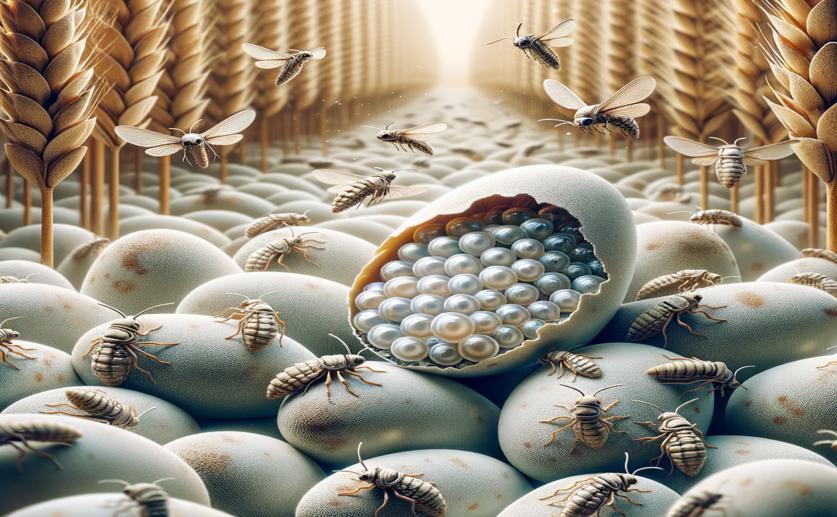Factors Influencing Two Parasitoid Species on Grain Moth Eggs

Image Source: Natural Science News, 2024
Key Findings
- The study was conducted to find eco-friendly ways to control Sitotroga cerealella, a major pest of grains
- Younger S. cerealella eggs were better for the development and reproduction of T. evanescens and T. bactrae
- Cold storage of S. cerealella eggs affected the success of rearing the parasitoids, with specific conditions improving parasitism rates
The Agriculture Research Center recently conducted a study to explore the effectiveness of two species of Trichogramma parasitoids, Trichogramma evanescens Westwood and Trichogrammatoidea bactrae Nagaraja, in controlling Sitotroga cerealella (Olivier), a significant pest affecting various grains[1]. This research is essential as it seeks to provide a sustainable and eco-friendly solution for managing cereal pests, which is a pressing issue for agricultural productivity.
The study focused on three main aspects: the age of S. cerealella eggs, the emergence time of the parasitoids, and the impact of cold storage on host eggs. These factors were analyzed to determine their influence on the rearing success of the two Trichogramma species.
Previous research has shown that the age of host eggs can significantly affect the parasitism rates and the development of Trichogramma parasitoids. For instance, a study on Trichogramma euproctidis demonstrated that younger Helicoverpa armigera eggs were more suitable for parasitoid development, leading to higher longevity and fecundity of the adult parasitoids[2]. Similarly, the current study aimed to identify the optimal egg age for S. cerealella to enhance the efficacy of T. evanescens and T. bactrae.
The experiments revealed that younger S. cerealella eggs were more favorable for the development and reproduction of both T. evanescens and T. bactrae. This finding aligns with prior research on different Trichogramma species, which indicated that younger host eggs generally result in better parasitism outcomes[2][3]. Additionally, the study found that the emergence time of the parasitoids was influenced by the age of the host eggs, with younger eggs leading to quicker emergence times.
Another critical aspect of the study was the evaluation of cold storage on host eggs. Cold storage is a common practice in mass rearing protocols to synchronize the availability of host eggs with the release of parasitoids. Previous studies have shown that the storage conditions and duration can significantly impact the parasitism rates and the quality of the emerging parasitoids. For example, research on T. evanescens indicated that the parasitism percentage varied with the storage duration and temperature of the host eggs[3]. In the current study, it was observed that cold storage of S. cerealella eggs did affect the rearing success of the parasitoids, with specific conditions leading to higher parasitism rates and better quality of the emerging adults.
The findings from this study provide valuable insights into optimizing the use of T. evanescens and T. bactrae for biological control of S. cerealella. By identifying the optimal egg age and understanding the effects of cold storage, this research offers practical guidelines for improving mass rearing protocols and enhancing the effectiveness of these parasitoids in pest management programs.
Overall, this study contributes to the growing body of knowledge on Trichogramma parasitoids and their application in biological control. It builds on previous research by confirming the importance of host egg age and storage conditions, while also expanding our understanding of the specific requirements for T. evanescens and T. bactrae. This research represents a significant step towards developing more efficient and sustainable pest management strategies for cereal crops.
AgricultureEcologyAnimal Science
References
Main Study
1) Studies of certain parameters affecting two parasitoid species, Trichogramma evanescens Westwood and Trichogrammatoidea bactrae Nagaraja (Hymenoptera: Trichogrammatidae), on egg host, Sitotroga cerealella (Olivier) (Gelechiidae: Lepidoptera)
Published 19th June, 2024
https://doi.org/10.1186/s41938-024-00797-1
Related Studies
Related Articles





 25th March, 2024 | Jim Crocker
25th March, 2024 | Jim Crocker